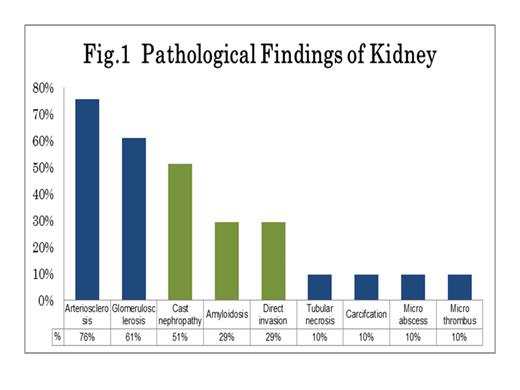Abstract
Kidney injury and/or renal failure are common complication in multiple myeloma. Well known mechanism is deposition of free immunoglobulin light chains in renal tubules leading to cast nephropathy and renal failure. In addition, not only cast nephropathy, but also invasion of myeloma cells is frequently found in autopsied cases of multiple myeloma.
Recent development of treatment improved the remission rate and survival of multiple myeloma. Few data exist about pathological findings of kidney injury and it is not well known about kidney findings in autopsy cases at era of novel agent. We investigated the pathological findings and the factors associated with kidney injury in the consecutively autopsy cases.
We reviewed the autopsy reports and medical records of 93 consecutively autopsied multiple myeloma cases between 1979 and 2012 at the National Medical Center for Global Health and Medicine in Tokyo, Japan. Patient profile, the clinical records including treatment and the duration of illness, the type of monoclonal gammopathy, clinical stage and history of treatment were studied. Durie & Salmon's criteria was used for diagnosis and staging. The pathological findings like cast nephropathy, invasion of myeloma cell at kidney and the other findings of whole samples were studied gross and microscopically. Immunohistochemistry and Congo-red stain were performed.
The pathological findings and the factors were statistically analyzed using Student's t-test and the chi-square test.
In 93 autopsy cases, 58% was male. Mean age and the duration of illness were 64.3(38-85) years old and 41 months (24.4-37.5). Thirteen patients and 14 were treated with SCT and hemodialysis (Table. 1). Cast nephropathy and direct invasion about kidney were observed in 51.2% and 29.3%, respectively. Other frequent finding associated with myeloma was renal amyloidosis (29%). Frequent non-specific findings were arteriosclerosis (76 %), glomerulosclerosis (61%). Combination of findings were found in 66% cases (Fig.1).
| Age at death . | 64.3 years old (38-85) . | ||||
|---|---|---|---|---|---|
| Time from diagnosis . | 41 months (1-156) . | ||||
| Sex . | Male 54 . | Female 39 . | |||
| Types of M protein | IgG | 49 | 52.7 % | ||
| IgA | 15 | 16.1 % | |||
| IgD | 8 | 8.6 % | |||
| BJP | 16 | 17.2% | |||
| Non-secretary | 1 | 1.1 % | |||
| NA | 4 | 4.3% | |||
| Initial treatment | |||||
| MP based chemotherapy | 66 | 71.0 | |||
| High dose melphalan with auto-SCT | 23 | 24.7 | |||
| Allo-SCT | 2 | 2.2 | |||
| None | 1 | 1.1 | |||
| Salvage therapy | |||||
| Chemotherapy | 69 | 74.2 % | |||
| Thalidomide | 9 | 9.7 % | |||
| Bortezomib | 15 | 16.1 % | |||
| Both | 6 | 6.5 % | |||
| Lenalidomide | 3 | 3.2 % | |||
| Age at death . | 64.3 years old (38-85) . | ||||
|---|---|---|---|---|---|
| Time from diagnosis . | 41 months (1-156) . | ||||
| Sex . | Male 54 . | Female 39 . | |||
| Types of M protein | IgG | 49 | 52.7 % | ||
| IgA | 15 | 16.1 % | |||
| IgD | 8 | 8.6 % | |||
| BJP | 16 | 17.2% | |||
| Non-secretary | 1 | 1.1 % | |||
| NA | 4 | 4.3% | |||
| Initial treatment | |||||
| MP based chemotherapy | 66 | 71.0 | |||
| High dose melphalan with auto-SCT | 23 | 24.7 | |||
| Allo-SCT | 2 | 2.2 | |||
| None | 1 | 1.1 | |||
| Salvage therapy | |||||
| Chemotherapy | 69 | 74.2 % | |||
| Thalidomide | 9 | 9.7 % | |||
| Bortezomib | 15 | 16.1 % | |||
| Both | 6 | 6.5 % | |||
| Lenalidomide | 3 | 3.2 % | |||
The tumor volume in bone marrow (percentage of myeloma cells in cellular component) had correlation to incidence of direct invasion (Pearson's correlation factor is 0.55, p<0.005).
Autopsy findings of the kidney are various, complicated pathological findings of two or more was not uncommon. Frequency of cast nephropathy was high, but the direct invasion of the tumor cells was observed in about one-third of the cases. Correlation was observed between the kidney and invasive tumor burden in the bone marrow. Therefore, in the advanced stage myeloma, when tumor cell occupy more than about 60% of the bone marrow should be considered renal failure mechanism by myeloma cell infiltration.
No relevant conflicts of interest to declare.
Author notes
Asterisk with author names denotes non-ASH members.


